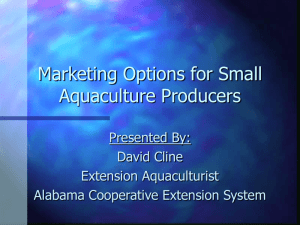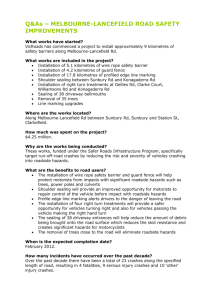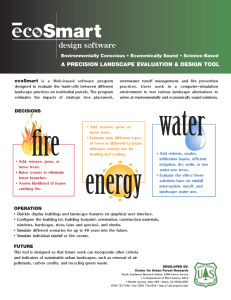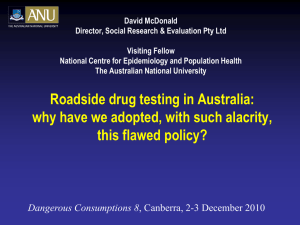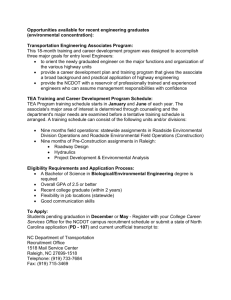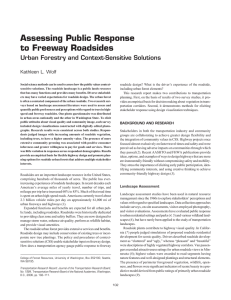ROADSIDE URBAN TREES Balancing Safety and Community Values By Kathleen L. Wolf
advertisement
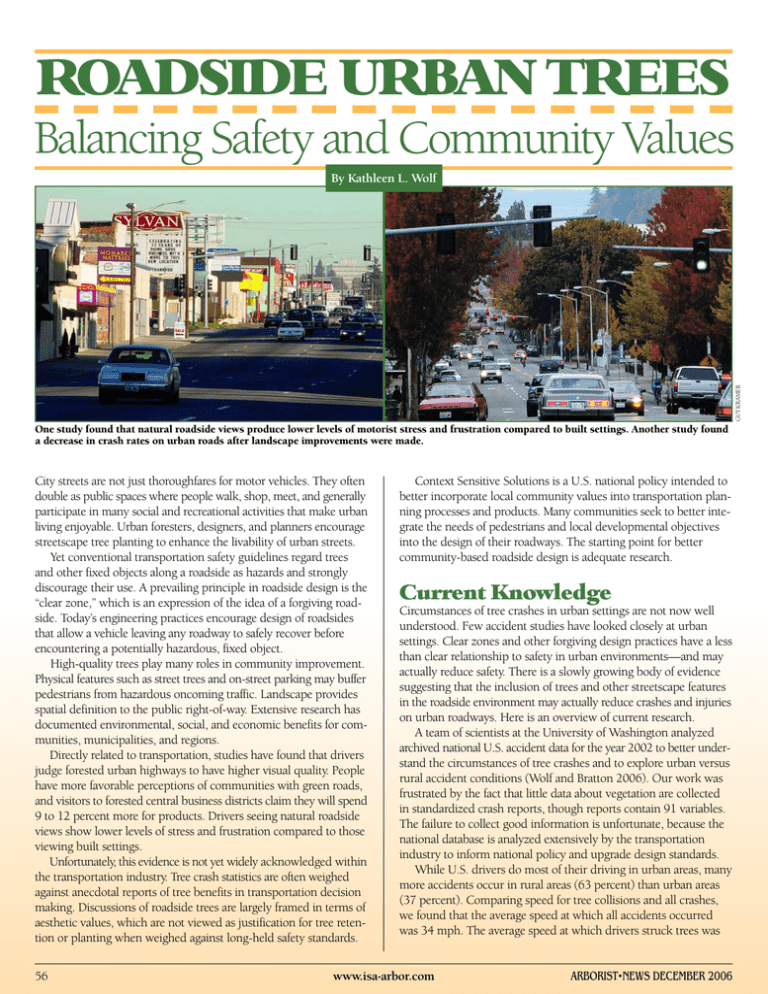
ROADSIDE URBAN TREES Balancing Safety and Community Values GUY KRAMER By Kathleen L. Wolf One study found that natural roadside views produce lower levels of motorist stress and frustration compared to built settings. Another study found a decrease in crash rates on urban roads after landscape improvements were made. City streets are not just thoroughfares for motor vehicles. They often double as public spaces where people walk, shop, meet, and generally participate in many social and recreational activities that make urban living enjoyable. Urban foresters, designers, and planners encourage streetscape tree planting to enhance the livability of urban streets. Yet conventional transportation safety guidelines regard trees and other fixed objects along a roadside as hazards and strongly discourage their use. A prevailing principle in roadside design is the “clear zone,” which is an expression of the idea of a forgiving roadside. Today’s engineering practices encourage design of roadsides that allow a vehicle leaving any roadway to safely recover before encountering a potentially hazardous, fixed object. High-quality trees play many roles in community improvement. Physical features such as street trees and on-street parking may buffer pedestrians from hazardous oncoming traffic. Landscape provides spatial definition to the public right-of-way. Extensive research has documented environmental, social, and economic benefits for communities, municipalities, and regions. Directly related to transportation, studies have found that drivers judge forested urban highways to have higher visual quality. People have more favorable perceptions of communities with green roads, and visitors to forested central business districts claim they will spend 9 to 12 percent more for products. Drivers seeing natural roadside views show lower levels of stress and frustration compared to those viewing built settings. Unfortunately, this evidence is not yet widely acknowledged within the transportation industry. Tree crash statistics are often weighed against anecdotal reports of tree benefits in transportation decision making. Discussions of roadside trees are largely framed in terms of aesthetic values, which are not viewed as justification for tree retention or planting when weighed against long-held safety standards. 56 Context Sensitive Solutions is a U.S. national policy intended to better incorporate local community values into transportation planning processes and products. Many communities seek to better integrate the needs of pedestrians and local developmental objectives into the design of their roadways. The starting point for better community-based roadside design is adequate research. Current Knowledge Circumstances of tree crashes in urban settings are not now well understood. Few accident studies have looked closely at urban settings. Clear zones and other forgiving design practices have a less than clear relationship to safety in urban environments—and may actually reduce safety. There is a slowly growing body of evidence suggesting that the inclusion of trees and other streetscape features in the roadside environment may actually reduce crashes and injuries on urban roadways. Here is an overview of current research. A team of scientists at the University of Washington analyzed archived national U.S. accident data for the year 2002 to better understand the circumstances of tree crashes and to explore urban versus rural accident conditions (Wolf and Bratton 2006). Our work was frustrated by the fact that little data about vegetation are collected in standardized crash reports, though reports contain 91 variables. The failure to collect good information is unfortunate, because the national database is analyzed extensively by the transportation industry to inform national policy and upgrade design standards. While U.S. drivers do most of their driving in urban areas, many more accidents occur in rural areas (63 percent) than urban areas (37 percent). Comparing speed for tree collisions and all crashes, we found that the average speed at which all accidents occurred was 34 mph. The average speed at which drivers struck trees was www.isa-arbor.com ARBORIST•NEWS DECEMBER 2006 48 mph, probably an outcome of the higher incidence of crashes in rural settings. We found an inverse relationship between driving volume and accident trends. About 62 percent of the miles traveled are in urban areas (totaling about 1.6 trillion), but most of the crashes with trees (61 percent) occur in rural areas. A study in Florida compared a section of road that had landscaping and other livability improvements with nearly identical roads that did not have community improvements (Dumbaugh 2005). Conventional street safety guidelines maintain that increased numbers of objects in the roadside and constrained rights-of-way will increase accident rates. Actually, as the investigator reported, “by any meaningful safety benchmark— total mid-block crashes, injuries, or fatalities—there can be little doubt that the livable section is the safer roadway.” Pedestrian and bicyclist injuries were likewise fewer in the improved road sections. Another study compared accidents before and after placement of landscape improvements on five arterial roadways in downtown Toronto, Ontario (Naderi 2003). The existence of features such as trees and planters in the urban roadside, based on pre- and posttests, resulted in reduced numbers of mid-block crashes on all test roads. The numbers of crashes decreased between 5 and 20 percent on studied roads, though mid-block crashes generally increased throughout the city. Did trees “cause” the reductions? The study couldn’t confirm that interpretation, but the investigator suggests that the presence of a well-defined road edge may cause drivers to be more attentive and cautious. Finally, a study of Texas urban roads found a decrease in crash rates on ten urban arterial and highway sites after landscape improvements were installed (Mok et al. 2006). Accident records were used to compare accident rates pre- and post-planting over three- to fiveyear time spans. The road sections were carefully screened from 61 possible sites. The science team acknowledged the limitations of the after-the-fact study but suggest that landscape may be an integral part of the safety management of urban roads. They note that “the landscape not only contributes to greater aesthetic compatibility between the urban environment and the highway but may contribute to a safer street.” Future Study Those who question prevailing roadside design standards do not intend to brush aside the consequences of tree crashes. There is indeed cause for concern. In 2003 alone, there were more than 8,500 fatalities involving roadside objects such as trees and utility poles on U.S. roadways, accounting for more than 20 percent of the total fatalities for that year (according to the National Highway Traffic Safety Administration). Nonetheless, it is important to put these numbers in perspective. Of the approximately 233 billion vehicle trips taken in the United States in 2002, trees were involved in 1.9 percent of all crashes. In total, the risk of an urban tree accident is about 1:100,000, or about the same risk level as injury in an airplane accident. Should zero level of risk be a community’s goal, or should other tree benefits and functions be considered a trade-off for some degree of safety? Such risk analysis is done for many other issues in our ARBORIST•NEWS DECEMBER 2006 society, such as treatment of rare diseases or regulation of pharmaceuticals. Risk assessment research could quantify the level of value a community places on trees and more livable streets. Driver behavior is another issue. Few studies have explored how drivers respond to roadside features. Elimination of a single roadside element, such as trees, will not eliminate risk. Driver error is a factor that contributes to more than 95 percent of traffic accidents. For instance, the most common situation for an accident is a winding and rural road, with the vehicle leaving the road on the outside of curves. Personal choices have great influence over the vehicle leaving the road, as well as the outcome of any crash that may occur. Drunk driving accounts for as much as half of all traffic fatalities. In all countries with high use of automobiles, male traffic fatalities outnumber female fatalities by about a factor of two. Many crashes occur on weekends and during late evening hours—and often involve excessive speeds. Drivers traveling in excess of posted speeds account for about 30 percent of all traffic fatalities. Meanwhile, seat belt use reduces a driver’s risk of death in a crash by 42 percent. Arboriculture science can contribute knowledge about trees and roadside environments in ways that improve forest health and human health alike. There needs to be better collaboration between urban foresters and the transportation officials to find better solutions for tree planting along city streets. The transportation industry is generally less aware of recent advances in roadside vegetation management, and engineers haven’t yet acknowledged that there are professional and scientific groups (such as ISA and the Society of Municipal Arborists) that could contribute to such studies. Transportation officials admit that research about urban roadside design in the United States is limited in both scope and quantity. Because of these limitations, city street designers apply principles learned in a rural highway environment to urban roads. Better urban roadway data systems and safety analysis should be created. Research resources are needed to better understand where and under what conditions urban forest and other streetscape improvements are hazardous, benign, or even helpful. Foresters and arborists can partner in research and design that result in safer and more livable streets. References Dumbaugh, E. 2005. Safe streets, livable streets. Journal of the American Planning Association 71(3):283–300. Mok, J.-H., H. C. Landphair, and J. R. Naderi. 2006. Landscape improvement impacts on roadside safety in Texas. Landscape and Urban Planning 78(3):263–274 (in press). Naderi, J.R. 2003. Landscape design in the clear zone: The effects of landscape variables on pedestrian health and driver safety. In Transportation Research Board, 82nd Annual Conference Proceedings [CD-ROM]. Transportation Research Board, Washington DC. Wolf, K.L., and N.J. Bratton. 2006. Urban trees and traffic safety: Considering U.S. roadside policy and crash data. Arboriculture & Urban Forestry 32(4):170–179. Kathleen L. Wolf is a research social scientist in the College of Forest Resources, University of Washington, Seattle. For more information about the study, e-mail Dr. Wolf at kwolf@u.washington.edu or visit www.cfr.washington.edu/research.envmind/transportation.html. www.isa-arbor.com 57
